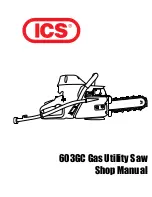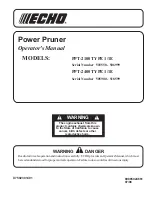
18
GB
(2). If this is not the case, the angle of the top saw band
roller (2) must be corrected.
• If the Bandsaw blade (21) runs more towards the rear
edge of the saw band roller (2) then the set screw (14)
must be rotated anticlockwise.
• Open the locking screw for the top saw band roller (13).
• Turn the bottom saw band roller (8) slowly by hand, to
check the position of the Bandsaw blade (21).
• If the Bandsaw blade (21) runs more towards the front
edge of the saw band roller (2) then the set screw (14)
must be rotated clockwise.
• After setting the top saw band roller (2), check the position
of the Bandsaw blade (21) on the bottom saw band roller
(8). The Bandsaw blade (21) should also lie centrally on
the saw band roller (8) here. If this is not the case, the an-
gle of the top saw band roller (2) must be adjusted again.
• Turn the saw band roller a few times, until the adjustment
of the top saw band roller (2) acts on the saw band posi-
tion on the bottom saw band roller (8).
• Tighten the locking screw for the top saw band roller (13).
• Once adjustment is complete, close the side covers (11)
again and secure with the cover locking mechanisms (10)
with the help of the screwdriver (29).
8.4 Adjusting the saw band guide (Fig. 5 - 8)
Both the support bearing (36 + 42) and the guide pins (37 +
46) must be readjusted after every saw band change.
• Open the side covers (11) by undoing the cover locking
mechanisms (10) with the help of the screwdriver (29).
8.4.1 Top support bearing (36) ( Fig. 5)
• Undo Allen screw for top support bearing (35).
• Move support bearing (36) sufficiently far that it just no
longer touches the Bandsaw blade (21) (distance max.
0.5 mm).
• Retighten the Allen screw for the top support bearing (35).
8.4.2 Adjusting the bottom support bearing (42)
(Fig. 7)
• Disassemble the saw table as per 9.1 in the opposite di-
rection.
• Undo Allen screw for bottom support bearing (41).
• Move bottom support bearing (42) sufficiently far that it
just no longer touches the Bandsaw blade (21) (distance
max. 0.5 mm).
• Retighten Allen screw for bottom support bearing (41).
8.4.3 Adjusting the top guide pins (37)
• Undo Allen screws for top retainer (40)
• Move top retainer (39), top guide pins (37), until the front
edge of the guide pins (37) is approx. 1 mm behind the
tooth base of the saw band.
• Retighten Allen screws for top retainer (40).
• ATTENTION! The saw band will be unusable if the teeth
touch the guide pins with the saw band running.
• Undo Allen screws for top guide pins (38).
• Slide the guide pins (37) in the direction of the saw band!
• Attention! The distance between the guide pins (37) and
Bandsaw blade (21) must not exceed 0.5 mm. (Saw band
must not jam)
• Retighten Allen screws (38).
• Before you actuate the On/Off switch, make sure that the
saw blade is correctly fitted and that the machine’s moving
parts run smoothly.
• Before you connect the machine to the power supply,
make sure the data on the rating plate is the same as that
for your mains.
8. Attachment
ATTENTION!
Before all maintenance, set-up and assembly work on the
band saw, unplug the mains plug.
Assembly tools
1 Open-ended spanner, size 10/13
1 Allen key, size 3
1 Allen key, size 4
1 Screwdriver
The saw table is not assembled for packaging reasons.
8.1 Assembling the saw table (Fig. 2-4)
• Remove the wing nut (31), the locking handle (20), the two
washers and the clamping plate (32). (Fig. 2)
• Remove the two knurled nuts (33), the U-reinforcement
(34) and the two countersunk screws M6x16 from the saw
table. (Fig. 3)
• Guide the saw table (7) over the Bandsaw blade (21).
Fasten it to the two screws on the machine frame with the
plate (32), the two washers, the wing nut (31) and the
locking handle (20). (Fig. 4)
• Fasten the U-reinforcement (34) to the front side of the saw
table with 2 countersunk screws M6x16 and 2 knurled
nuts (33). (Fig.3)
8.2 Tensioning the saw band (Fig. 1a)
• ATTENTION! If the saw is at a standstill for an extended
period the saw band tension must be relieved, i.e. before
switching the saw on it is necessary to check the saw
blade tension.
• Turn the clamping screw (1) clockwise to tension the Band-
saw blade (21). The correct tension of the saw band can
be determined by pressing the finger laterally against the
saw band, roughly centrally between the two saw band
rollers (2+8). The Bandsaw blade (21) should only de-
press slightly (approx. 1-2 mm) here.
• The sufficiently tensioned saw band makes a metallic
sound when tapped.
• Relieve the saw band tension if it is not in use for an ex-
tended time, so that it does not become overstretched.
• ATTENTION! With high tension, the saw band may break.
RISK OF INJURY! If the tension is too low, the driven saw
band roller (8) may spin, resulting in the saw band coming
to a standstill.
8.3 Adjusting the saw band (Fig. 1a+1b)
• ATTENTION! Before it is possible to implement the saw
band setting, the saw band must be tensioned correctly.
• Open the side covers (11) by undoing the cover locking
mechanisms (10) with the help of the screwdriver (29).
• Slowly turn the saw band roller (2) clockwise. The Band-
saw blade (21) should run centrally on the saw band roller
Содержание PBS 350 A1
Страница 6: ...15 16 14 12 48 26 13 6 24 21 25 10 5 21 11 49 50 12 7 7 7...
Страница 7: ...19 17 18...
Страница 31: ...24...
Страница 33: ......
Страница 35: ......












































